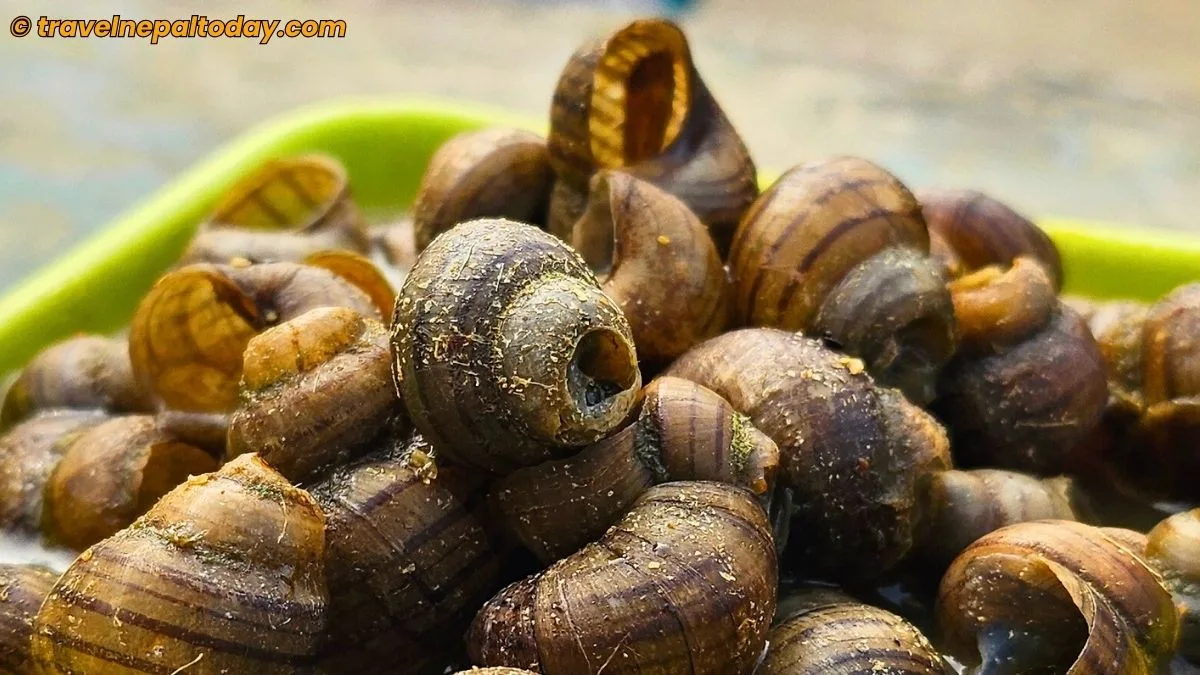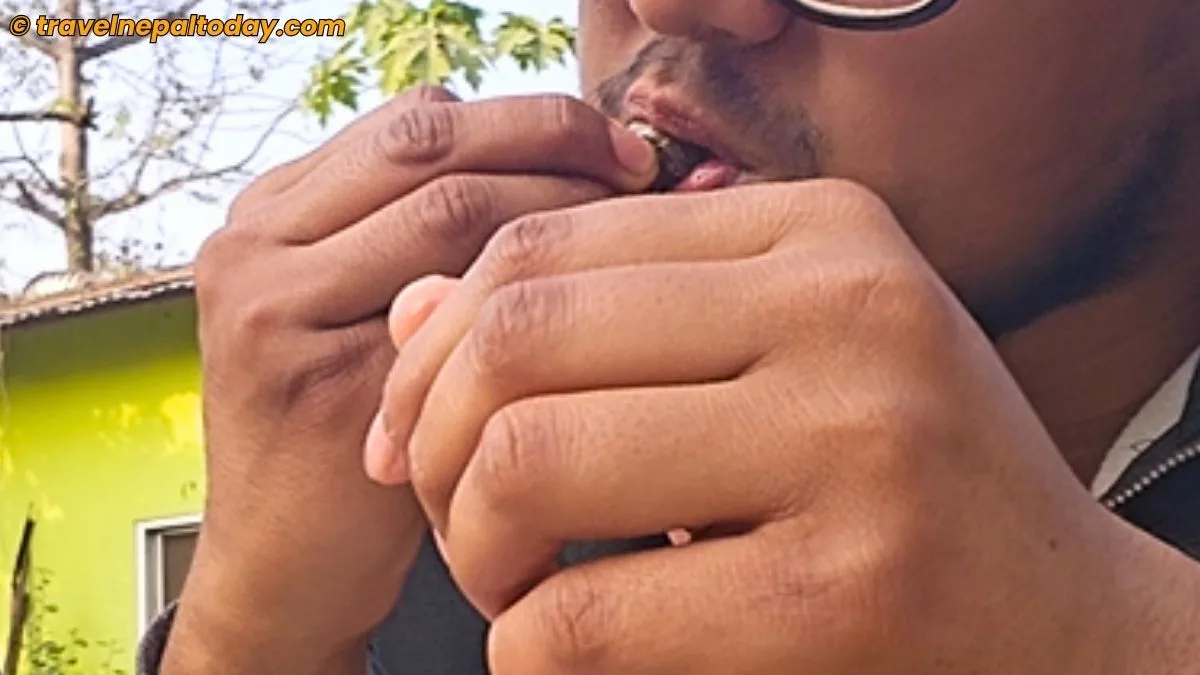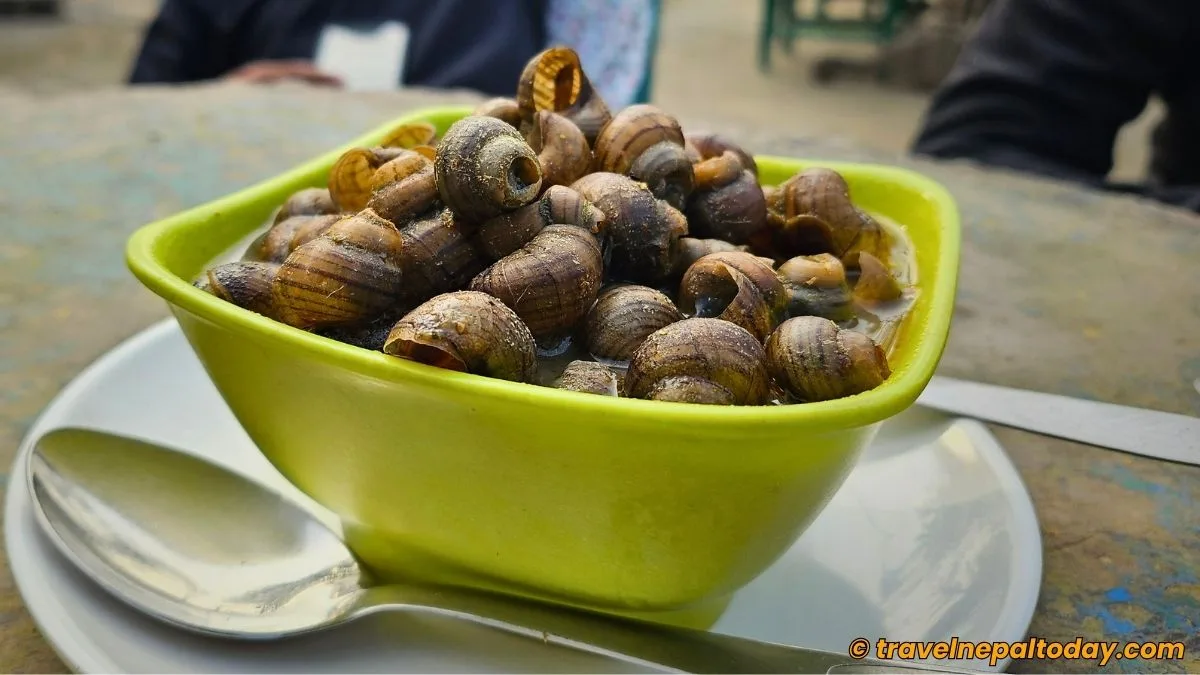If someone asked you to eat a snail, would you be willing to try it? Well, in Chitwan, people love it, and it’s one of the must-try dishes during your visit to Sauraha.
Ghongi is a traditional Tharu delicacy, typically enjoyed alongside ‘Dal Bhat’ or as a snack in the form of a simple soup.
These mud-water snails have been an integral part of culinary tradition for generations. They have even played a significant role in biological pest management for the indigenous Terai people.
Many claim that this delicacy is highly nutritious and offers various health benefits. But is that really the case?
In this article, we will take a deep dive into its fascinating method of farming, potential health benefits, the recipe, price, and how it tastes based on my personal experience after trying Ghongi in Chitwan.
Key Facts About Ghongi in Chitwan
| Type | Curry |
| Region | Terai region (most famous in Sauraha, Chitwan) |
| Cultural Roots | Tharu Community |
| Timing | Lunch / Dinner / Snacks |
| Price | NPR 150 to NPR 700 (varies based on restaurants) |
| Best Season | Monsoon |
What’s Ghongi Really?
Ghongi translates to ‘freshwater snail’ in English. If you’ve ever tried French Escargot or Bihari Doka, you’ll find that it’s quite similar to these types of snail dishes.
While the idea of consuming snails may sound a bit unappealing, the cleaning and boiling process of Ghongi ensures that it’s perfectly safe and delicious to eat.
These Tharu Escargots are harvested from rivers, streams, ponds, and paddy fields across the Terai region of Nepal. The mud-water snails are typically found beneath large rocks, most abundantly during the monsoon season.

Unlike other popular street foods of Sauraha, Ghongi is a traditional Tharu delicacy that’s usually served as part of lunch or dinner. However, if you’re just looking to taste it, you can order it at Tharu cultural restaurants and enjoy it like any other curry or soup.
According to an agricultural study conducted in Kapilvastu, Ghongi, also known as Pila globosa, was identified as one of the three snails responsible for vegetation damage. This clearly suggests that Ghongi is a natural pest.
The Tharu community has long been aware of this fact. While consuming snails as a form of pest control might seem unusual, this is exactly how the practice of eating Ghongi began.
In fact, the Tharu people firmly believe that Ghongi offers significant health benefits. So, you see, this cultural food isn’t just a natural and effective way to control pests—it’s also considered one of the best remedies for tackling diseases.
How Does Ghongi Taste? Sharing My Experiences
During my 1-day trip to Chitwan, I went for three things: motorboating in the Narayani River, Elephant Safari in Sauraha, and my first-ever Ghongi tasting experience.
When it comes to Ghongi, many of my friends immediately say No. Even among the five of us on the trip, only two were brave enough to try this Tharu delicacy.
Through this small survey itself, we come to know that at least 60% of people are unwilling to try Ghongi, even just for a one-time experience.
Of course, the two of us who gave it a go were doing it more for amusement. And honestly speaking, I had mixed feelings after tasting it.
We were served a bowl of Ghongi, which initially didn’t look too appetizing. But we were determined to try it, so we went for it anyways!

To eat Ghongi, all you have to do is suck the meat out of its shell. It gave me a feeling similar to sucking out the bone marrow from goat or buffalo bones (which I absolutely love).
The taste of the meat was pretty average, not as unpleasant as the expressions on our friends’ faces would suggest.
The soup also tasted fine and would have made a great curry if we had eaten it with rice (which we didn’t).
My only complaint was that we could taste the earthy soil and dirt, likely because it wasn’t cooked thoroughly? I’m not entirely sure.

To sum up my experience, I’d say it’s definitely worth a try, and there’s no need to grimace. Just make sure you’re trying Ghongi at a reliable restaurant or in a Tharu home, where they ensure the best food quality.
Where to Try Ghongi in Nepal?
While I tried Ghongi in one of the riverside restaurants in Sauraha, you can easily find it at any Tharu restaurant that serves regional cuisine. Ghongi is a well-known dish, and I’m quite certain most places offering Tharu food will have it on their menu.
However, the best way to truly experience and learn about Ghongi is in Sauraha itself or other Terai districts of Nepal.
It’s not just a Tharu delicacy—it’s equally loved by the Rajbanshi, Santhal, Jhangad, Bote, Musahar, and other Madehshi families.
Even in major cities like Kathmandu, Pokhara, and Butwal, some restaurants do offer Ghongi tasting. So, if you’re willing to try, you can visit one near you!
Since I’m open to trying Ghongi again (and likely many more times), I’ll soon update this article with recommendations for the best Ghongi restaurants in Nepal. Stay tuned!
How is Ghongi Cooked? Exploring Its Recipe
Before we dive into the health benefits of Ghongi, let’s first understand how it’s cooked. You definitely don’t eat the meat raw. There’s a rigorous process of cleaning and boiling before it’s ready for consumption.
Honestly, I haven’t prepared Ghongi myself, nor have I had the opportunity to take part in harvesting it. Hopefully, I’ll get the chance someday and share the experience with you all.
However, during my trip, I managed to learn about the cooking process from a local in Sauraha.
So, here’s a step-by-step process after analyzing what he told me along with my personal research on how Ghongi is prepared. Maybe you’ll even try cooking it yourself:
Step 1: Ghongi Harvesting
The first step in preparing Ghongi involves harvesting these apple snails.
For this, the people of the Terai visit paddy fields, rivers, or streams to collect as many Ghongi as possible. As I mentioned earlier, the monsoon is the time they are found abundantly, although Ghongi can be found year-round.
Has anyone of you ever tried harvesting Ghongi yourself? Let me know in the comments below!
Step 2: Soaking Snails and Cutting Their Tails
No, we don’t head straight to the kitchen just yet!
To remove excess mucus and dirt, the collected Ghongi are soaked in water with a sprinkle of rice flour for at least 24 hours.
Make sure to remove any snails that are floating. These are the dead ones, and we’re going to avoid them.
The snails that are alive will feed on the rice flour and expel all the mud and dirt from their bellies. This even helps reduce the bitterness of the meat!
The next day, cut off the pointed tails of each Ghongi. This makes it easier to suck the meat out of the shell.
And don’t forget to rinse the snails thoroughly (multiple times) before moving on to the next step.
Step 3: Gathering Cooking Materials (The Main Ingredients)
Now, it’s time to prepare the Ghongi for cooking. But before you fire up that pan, make sure you have these ingredients ready:
- Fenugreek seeds
- Ground linseed
- Vegetable Oil
- Ginger & Garlic Paste
- Green chillies
- Water
- Salt
- Turmeric Powder
- Coriander-Cumin Powder
I haven’t mentioned specific measurements because they depend on the quantity of snails being cooked. Also, the amount of spices can be adjusted according to your taste.
Step 4: Cooking Ghongi
Now that everything is ready, bring a pot of water to a boil and immerse all the Ghongi in it. Let them boil continuously until all the dirt and algae are removed.
Once that’s done, it’s best to rinse the snails once again. Better to be extra cautious, right?
After you’re completely satisfied with the cleaning, it’s time to start cooking.
Heat a pan, add oil, onions, Ghongi, and finally, the spices. Fry the snails well to enhance the flavors.
Finally, add water mixed with rice flour to thicken the gravy and make it more flavorful. Feel free to add your own tadka on this Ghongi recipe guide to suit your taste!
Step 5: Ready to Eat
Once the Ghongi curry or soup is boiled and ready, it’s time to serve and enjoy!
As I mentioned earlier, all you have to do is suck the meat out of the shells. And don’t forget to capture the moment! Make a video of yourself trying Ghongi and tag us in your social media posts or stories!
Is Ghongi Really Beneficial For Your Health?
Now that you’ve learned about the rigorous process of preparing Ghongi, you’re probably feeling more assured about its safety, right? But if you still have doubts, this section should clear them up.
Not only is Ghongi safe to eat, but it also holds impressive nutritional value. A study conducted at the BCSIR Campus in Rajshahi, Bangladesh, provides the following nutritional information for the apple snail (Pila globosa):
| Nutrition Composition | Percentage |
| Moisture | 75.31% |
| Protein | 33.81 |
| Fat | 1.8 |
| Oil Content | 2.3 |
| Oleic Acid | 20.37 |
| Lauric Acid | 14.3 |
| Palmitic Acid | 18.52 |
You see—Ghongi isn’t just a cultural delicacy; it’s a nutrient-rich food that could be a great addition to your diet!
Price of Ghongi in Chitwan
I vividly remember paying Rs. 250 for a bowl of Ghongi back in January 2024. The portion was just enough for the two of us first-timers.
However, the price of Ghongi in Chitwan varies depending on the restaurant, its type, and the overall demand (can be expensive during Tharu’s festive season).
As I mentioned earlier, I’m still exploring more about Ghongi and will soon update this article with recommendations for the best restaurants that serve authentic Tharu Escargot. So, bookmark this article right away!
Final Words
Hopefully, this blog has helped you learn more about Ghongi in greater detail and has motivated you to try this unique Nepalese dish.
Go ahead and give Ghongi a try, and don’t forget to share your experiences in the comments below!
Happy traveling to Chitwan!








